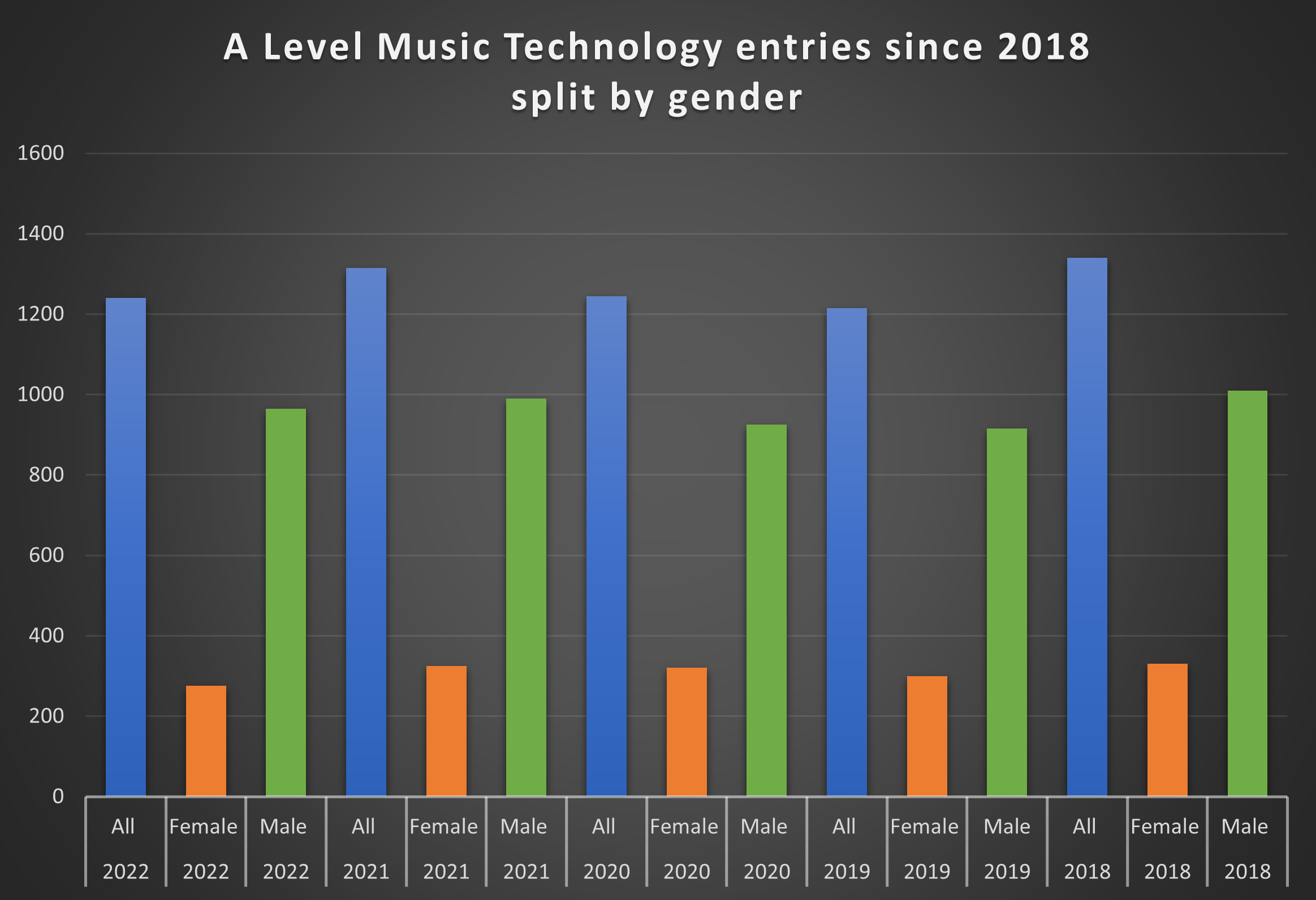
Over the last five years, only 24 per cent of A Level Music Technology students have been female, a freedom of information request to Ofqual has revealed.
Data obtained by MT has confirmed that there is an ‘alarming’ gender disparity in A Level Music Technology in England, with only one quarter of students taking the qualification between 2018 and 2022 being recorded as female.
The FOI also revealed the grade breakdown each year, demonstrating that grades received in Music Technology have followed a similar pattern to Music and other subjects during and following the peak of the pandemic. The percentage of students of both genders receiving A* or A was 9 per cent in 2019, rose to 25 per cent and 34 per cent in 2020 and 2021 respectively, and sat at 29 per cent in 2022.
 Table created by MT using Ofqual FOI data
Table created by MT using Ofqual FOI data
Attainment gap
As well as confirming the gender gap in the subject’s uptake, the data also revealed an attainment gap between male and female students. In 2022, for example, 33 per cent of male students were awarded top grades, compared to 14 per cent of female students. A similar gap can be seen across all years from 2018.
Head of music technology at Hills Road Sixth Form College and former MT tech editor Tim Hallas described the data as ‘alarming’. He said: ‘I work in a college with one of the largest Music Technology A Level cohorts in the country. I compared the FOI data to the data from my own college and they are largely in line. My college has a slightly higher percentage of female students than the national average – around 30 per cent – but this is still not good enough.’
‘The issue of gender in music technology is one that has been around for a long time and doesn’t seem to be improving fast enough. The work of Dr Eddie Dobson and the Yorkshire Sound Women Network has been incredibly important to the progression of the debate around gender in music production – but the data from these exam entries shows that there is still a long way to go.’
| Exam series | Candidates | A* | A | B | C | D | E | U |
| 2022 | All | 115 | 245 | 365 | 265 | 160 | 70 | 20 |
| 2022 | Female | 10 | 30 | 80 | 75 | 45 | 20 | 10 |
| 2022 | Male | 105 | 215 | 285 | 190 | 115 | 50 | 10 |
| 2021 | All | 140 | 320 | 360 | 295 | 140 | 50 | 10 |
| 2021 | Female | 25 | 65 | 90 | 80 | 50 | 15 | Fewer than 5 |
| 2021 | Male | 115 | 255 | 270 | 215 | 90 | 35 | 10 |
| 2020 | All | 90 | 230 | 395 | 335 | 145 | 50 | Fewer than 5 |
| 2020 | Female | 15 | 50 | 100 | 100 | 40 | 15 | Fewer than 5 |
| 2020 | Male | 75 | 180 | 295 | 235 | 105 | 35 | Fewer than 5 |
| 2019 | All | 20 | 90 | 265 | 390 | 285 | 125 | 45 |
| 2019 | Female | Fewer than 5 | 10 | 55 | 90 | 85 | 45 | 15 |
| 2019 | Male | 15 | 80 | 210 | 300 | 200 | 80 | 30 |
| 2018 | All | 35 | 115 | 290 | 405 | 305 | 155 | 40 |
| 2018 | Female | Fewer than 5 | 15 | 60 | 95 | 85 | 60 | 15 |
| 2018 | Male | 30 | 100 | 230 | 305 | 225 | 95 | 25 |
Gender gap begins at school
Kate Rounding, development director at Technology in Music Education UK (TiME), said that the data is 'disappointing', adding that 2022 has seen the publication of several research reports highlighting 'the continued gender disparity' across the wider music industry.
She continued: 'It appears that the gender gap in music begins at school. Outside of formal education, many young women participate in community-led projects; Youth Music reported that from 2020 to 2021, almost half of the participants in projects they funded were female.
'All these young women, in education and beyond, need to see female role models who are achieving and sustaining equitable careers. Support for schools around progression routes and employment options in the music industry could help to reassure parents that music is a viable career pathway for their daughters as well as their sons.'
Anecdotal observations
Hallas added that before the pandemic he had been working on an initiative with feeder schools to engage more young women in music technology – existing female students ran workshops for Year 10s before they attended sixth form open days. ‘Sadly, the pandemic put an end to this planning,’ he said, ‘but on reading this FOI data, I am reinvigorated to implement this straight away.’
Anecdotally, Hallas added that the attainment gap between male and female students shown by this data does not seem to be replicated in his college, although he has noticed that non-binary students ‘seem to struggle to attain higher grades more than students with other gender identities’.
He added: ‘There is not enough evidence to support this anecdotal observation from one college at the moment, but it is one I would encourage academics interested in exam attainment and gender identity to explore soon.’
The Ofqual data splits students into two gender categories and does not provide specific information on transgender students or those identifying as non-binary.








